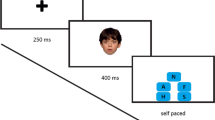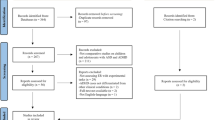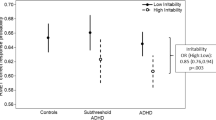Abstract
Autism is a highly heritable and clinically heterogeneous neuropsychiatric disorder that frequently co-occurs with other psychopathologies, such as attention-deficit/hyperactivity disorder (ADHD). An approach to parse heterogeneity is by forming more homogeneous subgroups of autism spectrum disorder (ASD) patients based on their underlying, heritable cognitive vulnerabilities (endophenotypes). Emotion recognition is a likely endophenotypic candidate for ASD and possibly for ADHD. Therefore, this study aimed to examine whether emotion recognition is a viable endophenotypic candidate for ASD and to assess the impact of comorbid ADHD in this context. A total of 90 children with ASD (43 with and 47 without ADHD), 79 ASD unaffected siblings, and 139 controls aged 6–13 years, were included to test recognition of facial emotion and affective prosody. Our results revealed that the recognition of both facial emotion and affective prosody was impaired in children with ASD and aggravated by the presence of ADHD. The latter could only be partly explained by typical ADHD cognitive deficits, such as inhibitory and attentional problems. The performance of unaffected siblings could overall be considered at an intermediate level, performing somewhat worse than the controls and better than the ASD probands. Our findings suggest that emotion recognition might be a viable endophenotype in ASD and a fruitful target in future family studies of the genetic contribution to ASD and comorbid ADHD. Furthermore, our results suggest that children with comorbid ASD and ADHD are at highest risk for emotion recognition problems.



Similar content being viewed by others
References
APA (2000) Diagnostic and statistical manual of disorders, 4th edn. Text Revision. American Psychiatric Association, Washington, DC
Freitag CM (2007) The genetics of autistic disorders and its clinical relevance: a review of the literature. Mol Psychiatry 12(1):2–22. doi:10.1038/sj.mp.4001896
Neves MD, Tremeau F, Nicolato R, Lauar H, Romano-Silva MA, Correa H (2011) Facial emotion recognition deficits in relatives of children with autism are not associated with 5HTTLPR. Revista brasileira de psiquiatria 33(3):261–267
Pelphrey KA, Shultz S, Hudac CM, Vander Wyk BC (2011) Research review: constraining heterogeneity: the social brain and its development in autism spectrum disorder. J Child Psychol Psychiatry Allied Discipl 52(6):631–644. doi:10.1111/j.1469-7610.2010.02349.x
Gottesman II, Gould TD (2003) The endophenotype concept in psychiatry: etymology and strategic intentions. Am J Psychiatry 160(4):636–645
Wang HM, Hsiao CL, Hsieh AR, Lin YC, Fann CS (2012) Constructing endophenotypes of complex diseases using non-negative matrix factorization and adjusted rand index. PLoS ONE 7(7):e40996. doi:10.1371/journal.pone.0040996
Almasy L, Blangero J (2001) Endophenotypes as quantitative risk factors for psychiatric disease: rationale and study design. Am J Med Genet 105(1):42–44
Viding E, Blakemore SJ (2007) Endophenotype approach to developmental psychopathology: implications for autism research. Behav Genet 37(1):51–60. doi:10.1007/s10519-006-9105-4
Waldman ID (2005) Statistical approaches to complex phenotypes: evaluating neuropsychological endophenotypes for attention-deficit/hyperactivity disorder. Biol Psychiatry 57(11):1347–1356. doi:10.1016/j.biopsych.2005.03.002
Allen AJ, Griss ME, Folley BS, Hawkins KA, Pearlson GD (2009) Endophenotypes in schizophrenia: a selective review. Schizophr Res 109(1–3):24–37. doi:10.1016/j.schres.2009.01.016
Hoff AL, Svetina C, Maurizio AM, Crow TJ, Spokes K, DeLisi LE (2005) Familial cognitive deficits in schizophrenia. Am J Med Genet Part B, Neuropsychiatr Genet: Off Publ Int Soc Psychiatr Genet 133B(1):43–49. doi:10.1002/ajmg.b.30120
Rommelse NN, Geurts HM, Franke B, Buitelaar JK, Hartman CA (2011) A review on cognitive and brain endophenotypes that may be common in autism spectrum disorder and attention-deficit/hyperactivity disorder and facilitate the search for pleiotropic genes. Neurosci Biobehav Rev 35(6):1363–1396. doi:10.1016/j.neubiorev.2011.02.015
Chen J, Calhoun VD, Pearlson GD, Ehrlich S, Turner JA, Ho BC, Wassink TH, Michael AM, Liu J (2012) Multifaceted genomic risk for brain function in schizophrenia. NeuroImage 61(4):866–875. doi:10.1016/j.neuroimage.2012.03.022
Doyle AE, Ferreira MA, Sklar PB, Lasky-Su J, Petty C, Fusillo SJ, Seidman LJ, Willcutt EG, Smoller JW, Purcell S, Biederman J, Faraone SV (2008) Multivariate genomewide linkage scan of neurocognitive traits and ADHD symptoms: suggestive linkage to 3q13. Am J Med Genet Part B, Neuropsychiatr Genet: Off Publ Int Soc Psychiatr Genet 147B(8):1399–1411. doi:10.1002/ajmg.b.30868
Rommelse NN, Arias-Vasquez A, Altink ME, Buschgens CJ, Fliers E, Asherson P, Faraone SV, Buitelaar JK, Sergeant JA, Oosterlaan J, Franke B (2008) Neuropsychological endophenotype approach to genome-wide linkage analysis identifies susceptibility loci for ADHD on 2q21.1 and 13q12.11. Am J Hum Genet 83(1):99–105. doi:10.1016/j.ajhg.2008.06.006
Tierney AL, Gabard-Durnam L, Vogel-Farley V, Tager-Flusberg H, Nelson CA (2012) Developmental trajectories of resting EEG power: an endophenotype of autism spectrum disorder. PLoS ONE 7(6):e39127. doi:10.1371/journal.pone.0039127
Soorya LV, Halpern D (2009) Psychosocial interventions for motor coordination, executive functions, and socialization deficits in ADHD and ASD. Primary Psychiatry 6:48–54
Anokhin AP, Golosheykin S, Heath AC (2010) Heritability of individual differences in cortical processing of facial affect. Behav Genet 40(2):178–185. doi:10.1007/s10519-010-9337-1
Harms MB, Martin A, Wallace GL (2010) Facial emotion recognition in autism spectrum disorders: a review of behavioral and neuroimaging studies. Neuropsychol Rev 20(3):290–322. doi:10.1007/s11065-010-9138-6
Sinzig J, Morsch D, Lehmkuhl G (2008) Do hyperactivity, impulsivity and inattention have an impact on the ability of facial affect recognition in children with autism and ADHD? Eur Child Adolesc Psychiatry 17(2):63–72. doi:10.1007/s00787-007-0637-9
Charbonneau G, Bertone A, Lepore F, Nassim M, Lassonde M, Mottron L, Collignon O (2013) Multilevel deficits in the processing of audio-visual emotion expressions in autism spectrum disorders. Neuropsychologia. doi:10.1016/j.neuropsychologia.2013.02.009
Uljarevic M, Hamilton A (2012) Recognition of emotions in autism: a formal meta-analysis. J Autism Dev Disord. doi:10.1007/s10803-012-1695-5
Downs A, Smith T (2004) Emotional understanding, cooperation, and social behavior in high-functioning children with autism. J Autism Dev Disord 34(6):625–635
Losh M, Adolphs R, Poe MD, Couture S, Penn D, Baranek GT, Piven J (2009) Neuropsychological profile of autism and the broad autism phenotype. Arch Gen Psychiatry 66(5):518–526. doi:10.1001/archgenpsychiatry.2009.34
Adolphs R, Spezio ML, Parlier M, Piven J (2008) Distinct face-processing strategies in parents of autistic children. Current Biol 18(14):1090–1093. doi:10.1016/j.cub.2008.06.073
Buitelaar JK, van der Wees M, Swaab-Barneveld H, van der Gaag RJ (1999) Theory of mind and emotion-recognition functioning in autistic spectrum disorders and in psychiatric control and normal children. Dev Psychopathol 11(1):39–58
Castelli F (2005) Understanding emotions from standardized facial expressions in autism and normal development. Autism: Int J Res Pract 9(4):428–449. doi:10.1177/1362361305056082
McCann J, Peppe S (2003) Prosody in autism spectrum disorders: a critical review. Int J Lang Commun Disord/Royal Coll Speech Lang Ther 38(4):325–350. doi:10.1080/1368282031000154204
Golan O, Baron-Cohen S, Hill JJ, Rutherford MD (2007) The ‘reading the mind in the voice’ test-revised: a study of complex emotion recognition in adults with and without autism spectrum conditions. J Autism Dev Disord 37(6):1096–1106. doi:10.1007/s10803-006-0252-5
Korpilahti P, Jansson-Verkasalo E, Mattila ML, Kuusikko S, Suominen K, Rytky S, Pauls DL, Moilanen I (2007) Processing of affective speech prosody is impaired in Asperger syndrome. J Autism Dev Disord 37(8):1539–1549. doi:10.1007/s10803-006-0271-2
Lindner JL, Rosen LA (2006) Decoding of emotion through facial expression, prosody and verbal content in children and adolescents with Asperger’s syndrome. J Autism Dev Disord 36(6):769–777. doi:10.1007/s10803-006-0105-2
Philip RC, Whalley HC, Stanfield AC, Sprengelmeyer R, Santos IM, Young AW, Atkinson AP, Calder AJ, Johnstone EC, Lawrie SM, Hall J (2010) Deficits in facial, body movement and vocal emotional processing in autism spectrum disorders. Psychol Med 40(11):1919–1929. doi:10.1017/S0033291709992364
Baker KF, Montgomery AA, Abramson R (2010) Brief report: perception and lateralization of spoken emotion by youths with high-functioning forms of autism. J Autism Dev Disord 40(1):123–129. doi:10.1007/s10803-009-0841-1
Grossman RB, Bemis RH, Plesa Skwerer D, Tager-Flusberg H (2010) Lexical and affective prosody in children with high-functioning autism. J Speech Lang Hear Res 53:778–793
Heikkinen J, Jansson-Verkasalo E, Toivanen J, Suominen K, Väyrynen E, Moilanen I, Seppänen T (2009) Perception of basic emotions from speech prosody in adolescents with Asperger’s syndrome. Logop Phoniatr Vocol 1:1–8
Jones CRG, Pickles A, Falcaro M, Marsden AJS, Happé F, Scott SK, Sauter D, Tregay J, Phillips RJ, Baird G, Simonoff E, Charman T (2011) A multimodal approach to emotion recognition ability in autism spectrum disorders. J Psychol Psychiatry 52:275–285
de Bruin EI, Ferdinand RF, Meester S, de Nijs PF, Verheij F (2007) High rates of psychiatric co-morbidity in PDD-NOS. J Autism Dev Disord 37(5):877–886. doi:10.1007/s10803-006-0215-x
Baird G, Brown D, Simonoff E, Pickles A, Charman T (2008) No evidence for MMR-ASD link. Practitioner 252(1704):6
Leyfer OT, Folstein SE, Bacalman S, Davis NO, Dinh E, Morgan J, Tager-Flusberg H, Lainhart JE (2006) Comorbid psychiatric disorders in children with autism: interview development and rates of disorders. J Autism Dev Disord 36(7):849–861. doi:10.1007/s10803-006-0123-0
Rommelse NN, Franke B, Geurts HM, Hartman CA, Buitelaar JK (2010) Shared heritability of attention-deficit/hyperactivity disorder and autism spectrum disorder. Eur Child Adolesc Psychiatry 19(3):281–295. doi:10.1007/s00787-010-0092-x
Nijmeijer JS, Hoekstra PJ, Minderaa RB, Buitelaar JK, Altink ME, Buschgens CJ, Fliers EA, Rommelse NN, Sergeant JA, Hartman CA (2009) PDD symptoms in ADHD, an independent familial trait? J Abnorm Child Psychol 37(3):443–453. doi:10.1007/s10802-008-9282-0
Corbett B, Glidden H (2000) Processing affective stimuli in children with attention-deficit/hyperactivity disorder. Child Neuropsychol: J Norm Abnorm Dev Child Adolesc 6(2):144–155. doi:10.1076/chin.6.2.144.7056
Da Fonseca D, Seguier V, Santos A, Poinso F, Deruelle C (2009) Emotion understanding in children with ADHD. Child Psychiatry Hum Dev 40(1):111–121. doi:10.1007/s10578-008-0114-9
Uekermann J, Kraemer M, Abdel-Hamid M, Schimmelmann BG, Hebebrand J, Daum I, Wiltfang J, Kis B (2010) Social cognition in attention-deficit/hyperactivity disorder (ADHD). Neurosci Biobehav Rev 34(5):734–743. doi:10.1016/j.neubiorev.2009.10.009
Shapiro EG, Hughes SJ, August GJ, Bloomquist ML (1993) Processing of emotional information in children with attention-deficit hyperactivity disorder. Dev Neuropsychol 9(3–4):207–224. doi:10.1080/87565649309540553
Van der Meer JMJ, Oerlemans AM, Van Steijn DJ, Lappenschaar MGA, De Sonneville LMJ, Buitelaar JK, Rommelse NNJ (2012) Are autism spectrum disorder and attention-deficit/hyperactivity disorder different manifestations of one overarching disorder? Cognitive and symptom evidence from a clinical and population-based sample. J Am Acad Child Adolesc Psychiatry 51(11):1160–1172
Berument SK, Rutter M, Lord C, Pickles A, Bailey A (1999) Autism screening questionnaire: diagnostic validity. Br J Psychiatry: J Mental Sci 175:444–451
Conners K (1996) Rating scales in ADHD. Duke University Medical Center, Durham
Corsello C, Hus V, Pickles A, Risi S, Cook EH Jr, Leventhal BL, Lord C (2007) Between a ROC and a hard place: decision making and making decisions about using the SCQ. J Child Psychol Psychiatry 48(9):932–940. doi:10.1111/j.1469-7610.2007.01762.x
Eaves LC, Wingert HD, Ho HH, Mickelson EC (2006) Screening for autism spectrum disorders with the social communication questionnaire. J Dev Behav Pediatr 27(2 Suppl):S95–S103
van Steijn DJ, Richards JS, Oerlemans AM, de Ruiter SW, van Aken MA, Franke B, Buitelaar JK, Rommelse NN (2012) The co-occurrence of autism spectrum disorder and attention-deficit/hyperactivity disorder symptoms in parents of children with ASD or ASD with ADHD. J Child Psychol Psychiatry 53(9):954–963. doi:10.1111/j.1469-7610.2012.02556.x
Lord C, Rutter M, Le Couteur A (1994) Autism diagnostic interview-revised: a revised version of a diagnostic interview for caregivers of individuals with possible pervasive developmental disorders. J Autism Dev Disord 24(5):659–685
Taylor E, Sandberg S, Thorley G, Giles S (1991) The epidemiology of childhood hyperactivity. Oxford University, New York
Rommelse NN, Oosterlaan J, Buitelaar J, Faraone SV, Sergeant JA (2007) Time reproduction in children with ADHD and their nonaffected siblings. J Am Acad Child Adolesc Psychiatry 46(5):582–590. doi:10.1097/CHI.0b013e3180335af7
Brookes K, Xu X, Chen W, Zhou K, Neale B, Lowe N, Anney R, Franke B, Gill M, Ebstein R, Buitelaar J, Sham P, Campbell D, Knight J, Andreou P, Altink M, Arnold R, Boer F, Buschgens C, Butler L, Christiansen H, Feldman L, Fleischman K, Fliers E, Howe-Forbes R, Goldfarb A, Heise A, Gabriels I, Korn-Lubetzki I, Johansson L, Marco R, Medad S, Minderaa R, Mulas F, Muller U, Mulligan A, Rabin K, Rommelse N, Sethna V, Sorohan J, Uebel H, Psychogiou L, Weeks A, Barrett R, Craig I, Banaschewski T, Sonuga-Barke E, Eisenberg J, Kuntsi J, Manor I, McGuffin P, Miranda A, Oades RD, Plomin R, Roeyers H, Rothenberger A, Sergeant J, Steinhausen HC, Taylor E, Thompson M, Faraone SV, Asherson P (2006) The analysis of 51 genes in DSM-IV combined type attention deficit hyperactivity disorder: association signals in DRD4, DAT1 and 16 other genes. Mol Psychiatry 11(10):934–953. doi:10.1038/sj.mp.4001869
Wechsler D (2002) WISC-III Handleiding. Psychological Corporation, London
Groth-Marnat G (1997) Handbook of psychological assessment, 3rd edn. Wiley, New York
De Sonneville LM, Verschoor CA, Njiokiktjien C, Op het Veld V, Toorenaar N, Vranken M (2002) Facial identity and facial emotions: speed, accuracy, and processing strategies in children and adults. J Clin Experiment Neuropsychol 24 (2):200–213. doi:10.1076/jcen.24.2.200.989
Vingerhoets G, Berckmoes C, Stroobant N (2003) Cerebral hemodynamics during discrimination of prosodic and semantic emotion in speech studied by transcranial doppler ultrasonography. Neuropsychology 17(1):93–99
De Sonneville LMJ (2005) Amsterdamse Neuropsychologische Taken: wetenschappelijke en klinische toepassingen. Tijdschrift voor Neuropsychology 1:27–41
De Sonneville LMJ (1999) Amsterdam neuropsychological task: a computer aided assessment program. In: Cognitive ergonomics, clinical assessment and computer-assisted learning: computers in psychology, vol 6. Swets and Zeitlinger, Lisse, The Netherlands, pp 204–217
Norusis MJ (1992) Statistical package for the social sciences, SPSS/PC+. McGraw-Hill, New York
Tabachnick BG, Fidell LS (2001) Using multivariate statistics, 4th edn. Allyn and Bacon, Needham Heights
Aylward GP, Brager P, Harper DC (2002) Relations between visual and auditory continuous performance tests in a clinical population: a descriptive study. Dev Neuropsychol 21(3):285–303. doi:10.1207/S15326942DN2103_5
Spencer MD, Holt RJ, Chura LR, Suckling J, Calder AJ, Bullmore ET, Baron-Cohen S (2011) A novel functional brain imaging endophenotype of autism: the neural response to facial expression of emotion. Trans Psychiatry 1:e19. doi:10.1038/tp.2011.18
Kaiser MD, Hudac CM, Shultz S, Lee SM, Cheung C, Berken AM, Deen B, Pitskel NB, Sugrue DR, Voos AC, Saulnier CA, Ventola P, Wolf JM, Klin A, Vander Wyk BC, Pelphrey KA (2010) Neural signatures of autism. Proc Natl Acad Sci USA 107:21223–21228
Hopkins IM, Gower MW, Perez TA, Smith DS, Amthor FR, Wimsatt FC, Biasini FJ (2011) Avatar assistant: improving social skills in students with an ASD through a computer-based intervention. J Autism Dev Disord 41(11):1543–1555. doi:10.1007/s10803-011-1179-z
Reichow B, Steiner AM, Volkmar F (2012) Social skills groups for people aged 6 to 21 with autism spectrum disorders (ASD). Cochrane Database Syst Rev 7:CD008511. doi:10.1002/14651858.CD008511.pub2
Gadow KD, Devincent CJ, Drabick DA (2008) Oppositional defiant disorder as a clinical phenotype in children with autism spectrum disorder. J Autism Dev Disord 38(7):1302–1310. doi:10.1007/s10803-007-0516-8
Guttmann-Steinmetz S, Gadow KD, Devincent CJ (2009) Oppositional defiant and conduct disorder behaviors in boys with autism spectrum disorder with and without attention-deficit/hyperactivity disorder versus several comparison samples. J Autism Dev Disord 39(7):976–985. doi:10.1007/s10803-009-0706-7
Cadesky EB, Mota VL, Schachar RJ (2000) Beyond words: how do children with ADHD and/or conduct problems process nonverbal information about affect? J Am Acad Child Adolesc Psychiatry 39(9):1160–1167. doi:10.1097/00004583-200009000-00016
Acknowledgments
This study was partly funded by a grant assigned to Dr. Rommelse by The Netherlands Organisation for Scientific Research (NWO grant # 91610024). The authors would like to thank all the parents, teachers, and children who kindly participated.
Conflict of interest
Oerlemans, Van der Meer, Van Steijn, De Ruiter, De Bruijn, and Rommelse have no conflict of interest to disclose. Dr. Buitelaar has been a consultant to/member of advisory board of/and/or speaker for Janssen Cilag BV, Eli Lilly, Bristol-Myer Squibb, Organon/Shering Plough, UCB, Shire, Medice, Servier, and Servier. De Sonneville is director of Sonares B.V., a company that commercially distributes the ANT program. He has been a consultant to/member of advisory board for Danone, Eli Lilly, Friesland Campina, and Global Pharma Consultancy.
Author information
Authors and Affiliations
Corresponding author
Electronic supplementary material
Below is the link to the electronic supplementary material.
Rights and permissions
About this article
Cite this article
Oerlemans, A.M., van der Meer, J.M.J., van Steijn, D.J. et al. Recognition of facial emotion and affective prosody in children with ASD (+ADHD) and their unaffected siblings. Eur Child Adolesc Psychiatry 23, 257–271 (2014). https://doi.org/10.1007/s00787-013-0446-2
Received:
Accepted:
Published:
Issue Date:
DOI: https://doi.org/10.1007/s00787-013-0446-2




